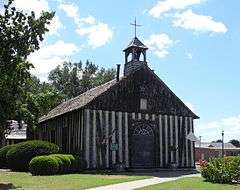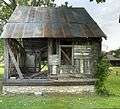Poteaux-sur-sol

Poteaux-sur-sol (Posts on a sill. Sol is also spelled sole and solle) is the name for a style of timber framing where relatively closely spaced posts rest on a timber sill by French settlers in the historical region of North America known as New France. Poteaux-en-terre and pieux-en-terre are similar but the closely spaced posts extend into the ground rather than resting on a sill on a foundation thus are a type of post in ground construction. Poteaux-sur-sol is similar to the framing style in the United Kingdom called close studding. Poteaux-sur-sol has confusingly also been used for other types of timber framing which have a sill timber such as post-and-plank, but is considered incorrect by some scholars.[1]
Poteaux-sur-sol is a part of American historic carpentry but is known by its French name in North America as it was used in French colonial architecture used by French and French-Canadian settlers in North America. It was also used by Ukrainian peasants living in the 19th century on the open steppes or anywhere there was a timber shortage.[2]
United States
Houses in this style in the present-day United States can be found in Ste. Genevieve, Missouri; Prairie du Rocher, Illinois, and former French settlements in Louisiana, all former parts of New France (La Louisiane). Most are listed on the National Register of Historic Places; Maison Bolduc (see below) is a National Historic Landmark.
Gallery
 Jacques Guibourd Historic House, c1806. Ste. Genevieve, MO An example of poteaux-sur-sol construction.
Jacques Guibourd Historic House, c1806. Ste. Genevieve, MO An example of poteaux-sur-sol construction. Front view of Louis Bolduc House, Ste. Genevieve. Shows poteaux-sur-sol construction and bousillage infill.
Front view of Louis Bolduc House, Ste. Genevieve. Shows poteaux-sur-sol construction and bousillage infill. A model of the Maison Bolduc in Ste. Genevieve, showing poteaux-sur-sol construction.
A model of the Maison Bolduc in Ste. Genevieve, showing poteaux-sur-sol construction. The Durand Cabin in Ste. Genevieve is an example of poteaux-sur-sol construction.
The Durand Cabin in Ste. Genevieve is an example of poteaux-sur-sol construction. Creole House in Prairie du Rocher, Illinois, built 1800, expanded with stud-based construction and sided in 1858.
Creole House in Prairie du Rocher, Illinois, built 1800, expanded with stud-based construction and sided in 1858.
See also
- Old Cahokia Courthouse
- French colonization of the Americas
- French architecture
- Poteaux-en-terre
- Pierrotage
- Bousillage
References
- ↑ Kniffen, Fred. B. and Henry H. Glassie. "Building in Wood in the Eastern United States: A Time-place Perspective" Geographical Review. Volume 56, Issue 1. American Geographical Society, 1966. Print.
- ↑ Lehr, John C., "Ukrainians in Western Canada", in To Build in a New Land (Baltimore and London: The Johns Hopkins University Press, 1992) pp 309-330.
| Wikimedia Commons has media related to Poteaux-sur-sol construction. |